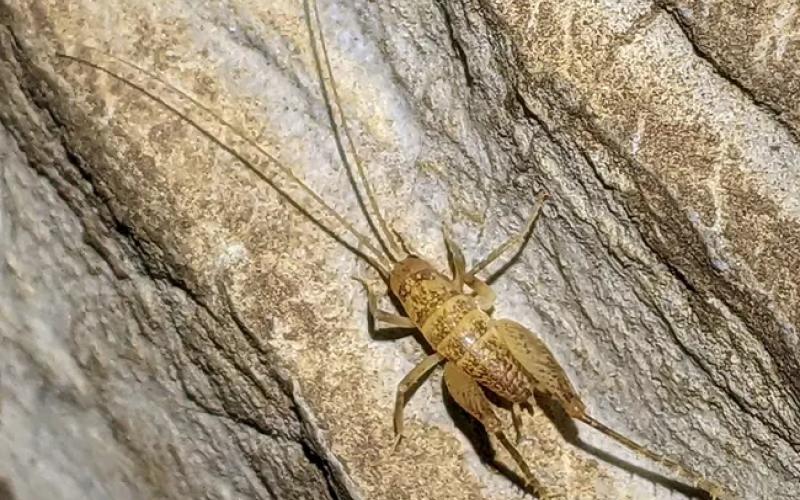The Midden: Meet the 2023 USA Cave Animal of the Year: Cave Crickets!

This article is the third in a series of posts showcasing articles published in the Summer 2023 issue of “The Midden”, Great Basin National Park’s semiannual resource management newsletter. The series will introduce you to some of the issues, projects, and management strategies currently happening in Great Basin National Park.
What lives underground? The Cave Animal of the Year project hopes to spread the news about the intriguing species that call underground home. Meet the 2023 designee: cave crickets.
Meet the 2023 USA Cave Animal of the Year: Cave Crickets!
By Jean Krejca and Shiloh McCollum, Great Basin Institute
The National Speleological Society (NSS) designates a Cave Animal of the Year to bring more attention to what lives underground. This year’s Cave Animal of the Year is one that lives in several caves in Great Basin National Park.
Perhaps you’ve seen them: the hop, hop of something moving in the cave, usually not too far from the entrance. What is it? You take a closer look and see something that makes you smile—a cave cricket!
There are a lot of different cave crickets throughout North America, including at least 33 species in the genus Ceuthophilus. These little creatures appear humpbacked and oblong with strong hind legs and very long antennae. The females are frequently larger than the males, and they frequently hang out by themselves underground in caves. They do not have wings and they do not have ears (called tympani). Instead of hearing sound, they feel vibrations from the hairs on their legs and with their long antennae.Cave crickets are important trogloxenes, which use caves a lot, but don’t always live in caves. They go outside the cave to eat, and then come back to hang out and nap. This is important to the cave ecosystem because they poop a lot, which brings a lot of resources in the cave for other insects and arachnids.
Cave crickets start out as eggs, and then look like miniature adults, just like you. They grow slowly, molting whenever they start to grow too big for their exoskeleton. Once they molt they look like bigger versions of themselves. Once they become adults, they don’t live very long, just long enough to mate and lay eggs, creating the next generation of cave crickets. We do not know a lot about how many eggs they lay, but it may be 2-6 at a time in loose soil. Throughout their lifetime, they may lay anywhere from 30-60 eggs. And how long is that lifetime? Some cave crickets may live just one year, but others may live closer to two years.
We humans have been hanging out with cave crickets for a long time. There is a carving of a cave cricket in France that is at least 12,000-17,000 years old. Even one of the caves in Great Basin National Park has a pictograph that might be a cave cricket.
Where Can I Find Cave Crickets?
Ceuthophilus crickets are generally found in caves, but not always. Within caves they are often found on the walls and ceilings, but sometimes under rocks, too. Some of them will only go into caves occasionally and will hang out under rotting logs, rocks, in boulder fields, and other habitats that avoid sunlight. Most crickets will live in caves most of the time, only going outside to forage every few days. A few of them are more cave adapted and never leave the cave. It usually depends on the species and what is available in the surrounding habitats. Most crickets require a relatively constant temperature and humidity, which is why caves are preferred over other habitats. The family Rhaphidiphoridae is worldwide and the genus Ceuthophilus occurs in Canada through to Mexico.
What Do Cave Crickets Eat?
Cave crickets are omnivores. They eat what is available, and have been observed feeding on plants (fruit, grasses), meat (tuna fish), mushrooms, and human/junk food leftovers. Like many invertebrates, they switch between food sources multiple times throughout a night in order to ensure their dietary needs get met. Crop studies in New Mexico indicate much of the diet of crickets found near the cave entrance consists of green plant materials (leaves, grasses). Foraging range studies in Texas show that crickets painted at cave entrances travel over 100 m from the entrance as part of their nightly travels, and also that they travel overland from one cave to another quite frequently.
Why are Cave Crickets Important?
Cave crickets forage outside of the cave, then come into the cave where they leave guano, exoskeleton sheds, eggs, and their own bodies after they die. These are sources of nutrients for cave-limited fauna. Since there is no primary production in the majority of caves, the nutrients that trogloxenes like bats and crickets bring in, along with that from flooding, is critically important for the ecosystem. In particular, cave crickets travel to diverse areas within a cave, spreading these sources of nutrition in different ways than bats and floods. At least one endangered ground beetle genus, Rhadine, is known to specialize on cave cricket eggs. Cave crickets use their ovipositors to lay eggs into small holes in the clay or silt walls, and the cave-adapted beetle ‘sniffs out’ the tracks where the crickets have walked and sometimes finds the hole with the nutrient-rich egg.
To learn more about cave crickets, visit the NSS Cave Animal of the Year website.
Photo: Cave crickets are often a tan color and may blend in well with the cave wall. NPS/Gretchen Baker.
